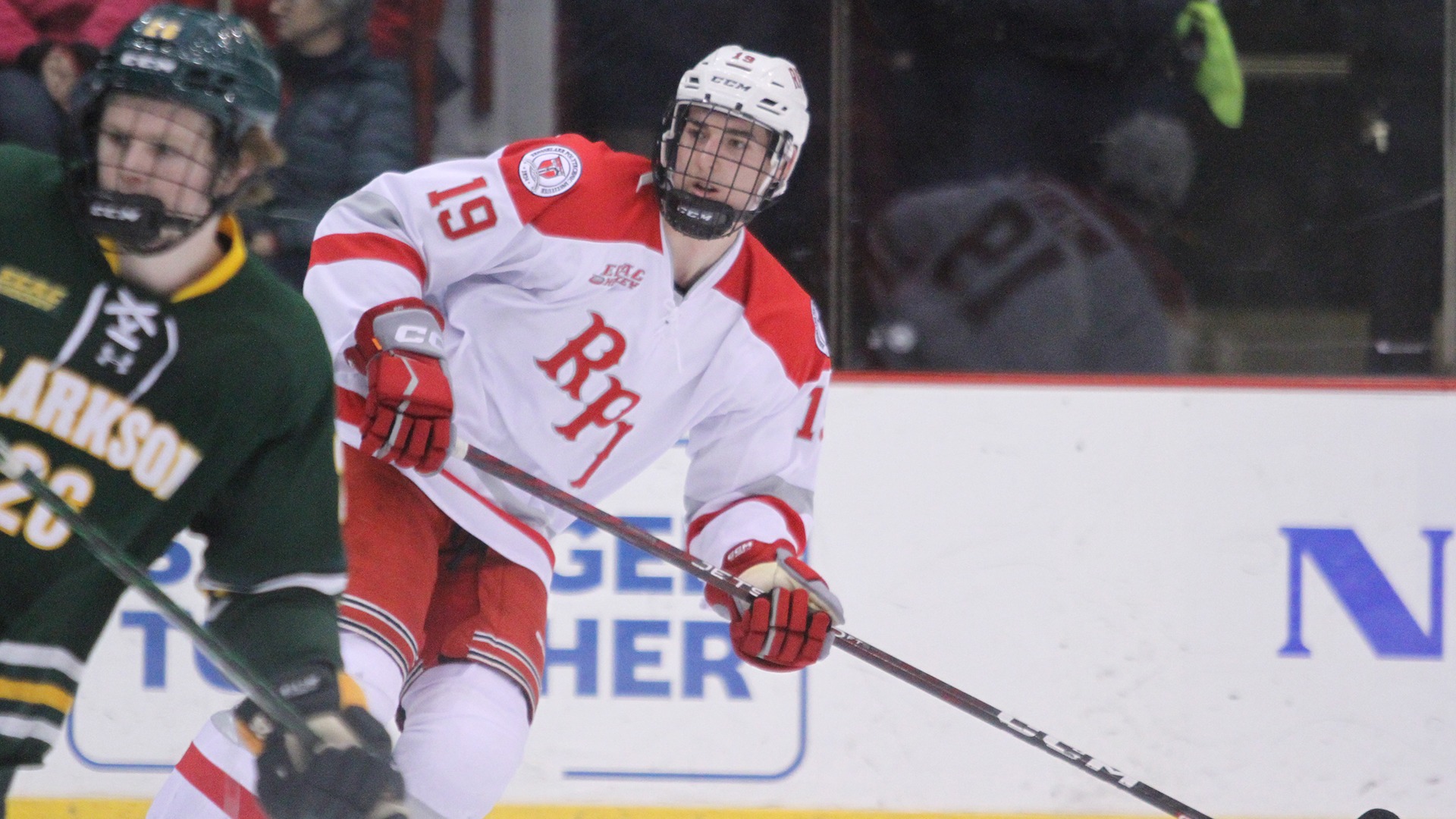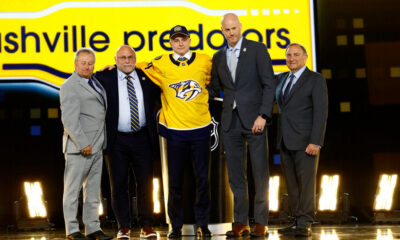A few weeks before the 2023 NHL Draft, incoming Nashville Predators GM Barry Trotz told his scouts that he wanted to take big swings with their league-most 13 picks. A few days before the draft, Trotz somewhat clarified on the 32 Thoughts podcast that he wants the team to take swings with their top picks and that later rounds can be used to find safer depth players.
11 picks later, Nashville is now welcoming a new class of prospects. Meanwhile, how did Trotz’s debut draft philosophy turn out? Truthfully, it was a mix of new and old. The Predators took some swings, particularly with their first few picks, and they went the reliable route with some project picks too, potentially indicating that David Poile still had his fingerprints on his final NHL draft. So what do those swings look like and will those projects be worth it? Let’s examine.
Sutter Muzzatti (F) | RPI (NCAA) | 143rd overall
| Season | Team | League | GP | G | A | PTS |
| 2021-22 | Austin Bruins | NAHL | 50 | 12 | 34 | 46 |
| 2022-23 | RPI | NCAA | 35 | 7 | 15 | 22 |
Their second overage player of the 2023 NHL Draft class, Sutter Muzzatti is the selection I’m lowest on. The 20-year-old forward was in his last year of draft eligibility after finishing his freshman season for the RPI Engineers. Before heading to the NCAA, Muzzatti played two seasons in the NAHL, posting 59 points in 80 games. With RPI, he scored seven goals and 22 points in 35 games, finishing tied for the team lead in points.
At 6’5″, Muzzatti (#19, white) does remind me a lot of Jachym Kondelik in his draft year. He’s a massive pivot (who did play some wing this year), who excels as a net-front screen—particularly on the power play. But he also played a good amount in the bumper spot on the goal line, improving his puck distribution skills as the year went on. Even if he corrects some of his deficiencies, which I’ll get to, Muzzatti will be scoring a lot of rebound and deflection goals at the next level.
Muzzatti’s puck skills aren’t bad. He’s got a decent set of hands that helps him in transition as seen above. He could stand to diversify where around his body he holds the puck a bit more, but all in all, he’s an okay handler. His size and puck protection skills help him push defenders back upon zone entry, and, at times, carry them with him, drawing space open for his teammates.
On the forecheck, Muzzatti uses his size to his advantage, pasting opponents against the wall and dislodging the puck. Defensively, he often lunges for pucks or sticks realizing he can’t get to plays in time via his feet. I also think he lacked discipline in his defensive-zone positioning at times this year. He chases the puck, doesn’t frequently scan off-puck movements, and tries to hit everyone regardless of if it’s helpful or not.
But, skating is the real issue. His knee bend could improve, and his strides take time to reach complete extension. His accelerating gear is severely lacking, and he doesn’t anticipate plays enough to make up for it right now.
The temptation to pick him is obvious: he’s 6’5″ with an okay scoring touch. Nashville figures that if they can fix his skating, they may have something here. But this feels like a classic Poile late-round pick, going after a guy they could’ve likely signed as an undrafted free agent next summer instead of swinging on skill.
Austin Roest (F) | Everett Silvertips (WHL) | 175th overall
| Season | Team | League | GP | G | A | PTS |
| 2021-22 | Everett Silvertips | WHL | 59 | 13 | 19 | 32 |
| 2022-23 | Everett Silvertips | WHL | 60 | 32 | 46 | 78 |
Contrary to Muzzatti, I’m a huge fan of the Austin Roest pick; I even included him on my potential Predators’ sixth-round draft board. Yes, Roest is another overage skater, but I wouldn’t consider him a classic safe pick.
The 5’10” forward went undrafted last year after scoring 13 goals and 32 points in 59 games. This year, he set out to prove 32 teams wrong, posting 32 goals and 78 points in 68 games while wearing a letter for the Everett Silvertips; he finished second on the team in scoring.
Roest (#14, white) isn’t the fastest skater on the ice, but he plays with a really good pace, covering 200 feet seemingly with ease. He’s undersized but battles hard for every puck as we can see along the wall early in the clip above. Roest thrives off of a give-and-go style of offense; he connects on small passes and is shifty with the puck, evading defenders with good hands.
He keeps his head up in transition, handling the puck well at his top speed. Once he makes a cross-ice or drop pass, he bursts into open ice and prepares to receive the puck back. He can exploit stingy defenses that play lanes tightly by pulling defenders with him before offloading the puck and zooming past them into open ice. His versatility forces opponents to respect a lot of assets of his game.
Defensively, Roest’s game has grown a lot this year. He tangles up opponents in front of his net and scans for others trying to find open ice before jumping into their space.
On the forecheck, Roest is tenacious, bugging defenders significantly bigger than him to force giveaways before setting up teammates for a scoring chance.
On top of all that, Roest possesses crafty hands and some good puck skills. He’s not the hardest shooter, but he is accurate and puts on a dazzling move with the puck every couple of shifts.
This is the exact kind of pick I hope we see more of from Barry Trotz in future drafts. With this much capital, the organization should feel fine taking their chance on smaller, elusive players who can drive possession at a quick pace.
Aiden Fink (F) | Brooks Bandits (AJHL) | 218th overall
| Season | Team | League | GP | G | A | PTS |
| 2021-22 | Brooks Bandits | AJHL | 60 | 19 | 34 | 53 |
| 2022-23 | Brooks Bandits | AJHL | 54 | 41 | 56 | 97 |
Remember the name Aiden Fink. At worst, he’ll be the answer to a trivia question in five years: who was David Poile’s last-ever draft pick? A player he knew nothing about.
Fink comes from the not often tapped AJHL, where he’s starred for the Brooks Bandits for the past two years. He led the league in scoring this year with 41 goals and 97 points in 54 games; he’s combined for 150 points in 114 games over both seasons.
Right now, I think the Penn State commit is little more than a late-round lottery ticket. But it’s the seventh round, and he has some notable skill, so you never know.
Fink’s (#9, blue) biggest drawback is his size; he comes in at just 5’9″. Besides that, he has above-average puck skills and often dances around the offensive zone, distributing the puck to whoever can get open.
In transition, he’s a largely effective puck mover. He plays with an okay pace, keeps his head up, can make opponents miss with clever dekes, and uses give-and-go passes to create scoring chances.
Fink plays a solid off-puck game both in transition and in the offensive zone. He’s not the most aggressive forechecker but carves out a good role as an F2 or F3. Fink anticipates plays and his teammates’ movements well, reacting to that to make plays or find open ice to bury the puck from.
He’s also a decent shooter from a distance, becoming a big-time weapon on Brooks’ power play. With added strength, I imagine that skill will improve in his NCAA years too.
The other flaws to Fink’s game compound his small stature. While he can be elusive in the neutral zone, using linear crossovers to confuse defenders, his skating mechanics aren’t amazing. He often extends his legs more laterally than behind him, and his stride recoveries are inconsistent. He doesn’t have the speed that someone of his height likely needs to succeed.
On top of that, Fink has mastered the perimeter of the offensive zone, but I think he’ll struggle to cut to high-danger areas against college defenders, especially if he can’t pick up his acceleration. I’m sure that in three or four years, he’ll be a top scorer for the Nittany Lions, but right now, I don’t see much of an NHL future for Aiden Fink.
All statistics are courtesy of eliteprospects.com.

















